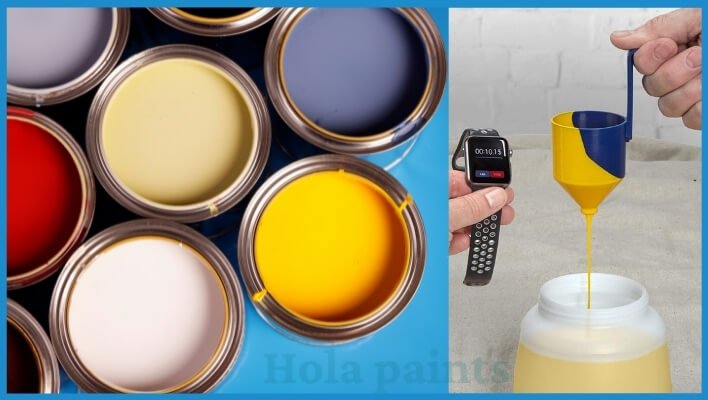Ever wondered if you can paint brass? Yes, absolutely you can! Painting brass is a great way to make old items like lamps and fixtures look fresh and new. But it’s important to prepare the brass properly before painting.
Brass is a tough metal, but with the right techniques, you can give it a whole new look with paint. Whether you’re updating an old brass doorknob or adding a pop of color to a metal light fixture, painting brass can be a fun and rewarding DIY project.
A while back, I decided to freshen up my brass door knobs with spray paint, but forgot to prep them first. So today, in this blog post, I’ll cover everything you need to know to paint brass door knobs effectively, ensuring the paint doesn’t chip or peel over time. I’ll also discuss potential issues you might encounter and offer some helpful advice based on my own experience painting brass black for the first time.
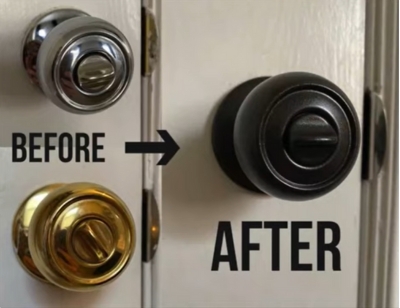
Table of Contents
- How to Paint Brass Black?
- Step 1: Gather Materials
- Step 2: Remove the Doorknobs
- Step 3: Clean the Doorknobs & Prepare It
- Step 4: Apply the Spray Paint
- Step 5: Apply Clear Enamel
- Step 6: Let it Cure:
- Step 7: Reinstall Doorknobs:
- Can you paint brass light fixtures?
- When it is Ok to paint or color brass?
- Which brass material should not be painted?
- Can you paint polished brass door knobs?
- How to Paint Over Brass or Metal?
- Conclusion:
- FAQS
- Can Brass Be Painted?
- What Kind of Paint Will Stick to Brass?
- Can you put varnish on brass?
- Can I paint lacquered brass?
- Rosalie Sanchez
How to Paint Brass Black?
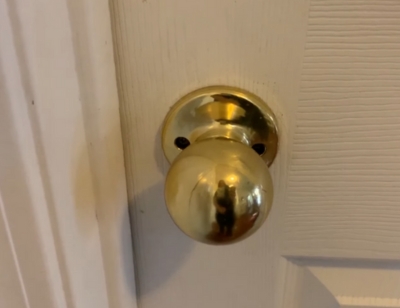
When considering how to paint brass hardware black, it’s important to recognize that while brass is a durable metal, painting it requires careful preparation and execution. With the right steps and materials, you can easily enhance the look of brass items like lamps, drawer pulls, faucet, candlesticks, light fixtures, fireplace doors, and metal garage door handles.
Step 1: Gather Materials
- Screwdriver
- Cleaner like TSP
- A towel
- Oil rubbed bronze spray paint
- Clear enamel spray
- Buffing block or sandpaper
- Protective gear like gloves and goggles
Step 2: Remove the Doorknobs
Using your screwdriver, carefully remove the brass doorknobs from the doors. Keep track of the screws and parts.
Step 3: Clean the Doorknobs & Prepare It
Usually I mix the heavy-duty cleaner with water and use it to thoroughly clean the doorknobs. This step helps the paint adhere better. Also I roughen up the surface of the brass knobs using a buffing block or sandpaper. Learn more about sanding metal in detail.
Step 4: Apply the Spray Paint
Here I was using a light coat of oil rubbed bronze spray paint to the knobs in a proper ventilated room. Be sure to spray evenly and avoid heavy layers to prevent drips. Let the first coat dry completely. After that you can apply an additional coat, if needed.
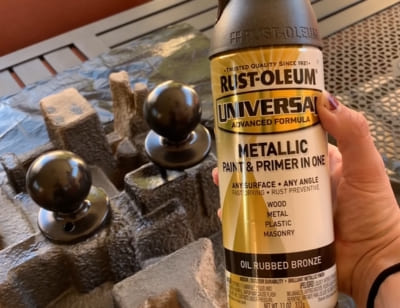
As for the best spray paint for brass, many DIYers recommend using Rust-Oleum Universal Metallic Spray Paint in Brass. It provides great coverage with a durable finish, perfect for updating your doorknobs.
Step 5: Apply Clear Enamel
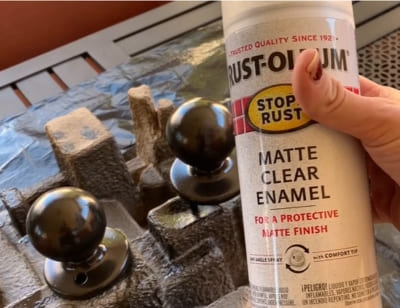
Once the paint is dry, apply a coat of clear enamel spray to protect the finish and prevent chipping. This step adds durability to your newly painted knobs.
Step 6: Let it Cure:

After the final coat of paint, let the doorknobs sit for at least a week to air out and cure. This helps reduce any lingering paint smell and ensures the paint sets properly.
Step 7: Reinstall Doorknobs:
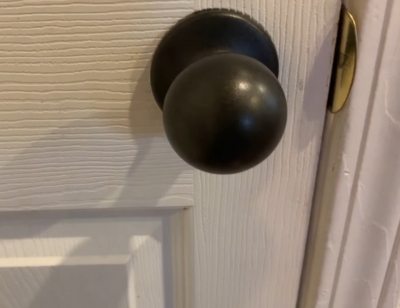
Once the paint has cured, reinstall the doorknobs using a screwdriver to avoid chipping the paint.
Finally, with these simple steps, you can easily transform outdated brass doorknobs into modern fixtures that enhance the look of your home. Enjoy your refreshed doors!
Can you paint brass light fixtures?
- Yes you can paint brass materials with the right approach. Here’s a step-by-step guide on how to paint brass light fixtures.
- First check your brass light fixtures. If they’re still in good condition but need a makeover, painting them could be a cost-effective solution.
- Get everything you need for the project. Rust-Oleum Oil Rubbed Bronze Spray Paint will be your main paint choice, along with spray paint primer, a clear sealer (opt for satin or matte finish), and cleaning materials like multipurpose cleaner, an old toothbrush, and rags or paper towels.
- Don’t forget optional items like cardboard or a drop cloth for workspace protection, and old styrofoam for holding screws.
- Prioritize safety by turning off power to fixtures and dismantling them cautiously.. This prevents any accidents while you’re working on them.
- Give each part of the fixtures a thorough cleaning using a multipurpose cleaner and an old toothbrush. Removing all dust, dirt, and debris ensures better paint adhesion.
- Apply a primer coat to all the brass surfaces. If you plan to paint items that are frequently touched, like door knobs, consider lightly sanding them beforehand for improved paint adhesion.
- Once the primer is dry, start painting with the Rust-Oleum Oil Rubbed Bronze paint. Use light, even coats to avoid drips, and maintain a consistent spraying motion for uniform coverage.
- Don’t forget about the smaller parts like nuts and bolts. Paint them with the same care and technique, using a styrofoam holder to keep them steady.
- After paint dries, apply a clear sealer for added protection. Allow everything to dry overnight for optimal results.
- Once everything is dry, reassemble the fixtures, and reinstall them in their original locations.
When it is Ok to paint or color brass?
Painting brass can be a great way to spruce up old or outdated items and match them to your decors. Here are some reasons where it’s generally fine to paint brass:
- If the brass item looks tired or out of style, painting it can give it a fresh, updated appearance.
- If you prefer a different color or finish than natural brass, painting allows you to customize the item to your liking.
- When the brass piece clashes with your decors, painting it can help it blend in seamlessly with the rest of the room.
- Painting brass can safeguard it from tarnishing or corroding, especially if it’s exposed to outdoor elements or high humidity.
- Transforming old brass items for new purposes often involves painting them to suit their new role.
However, consider a few things before grabbing the paintbrush:
- If the brass item is antique or valuable, painting it might lower its worth. Seek expert advice before altering valuable pieces.
- Opt for paints made for metal surfaces, like spray paints designed for metal or enamel paints, for a durable finish.
- Painted brass might need touch-ups or upkeep, especially in high-traffic areas, to keep it looking good over time.
Which brass material should not be painted?
When it comes to brass items, painting can significantly impact their value, functionality, and appeal. Antique pieces can lose charm if coated in paint, while functional fixtures like doorknobs may suffer from premature wear.
High-temperature brass items should remain unpainted to prevent damage and health risks. Understanding each item’s functionality before considering cosmetic alterations is crucial.
Household brass items should generally be left unpainted unless purely decorative. However, those seeking creativity can transform eating and drinking pieces into unique artistic displays through painting, preserving their integrity and aesthetic potential.
Can you paint polished brass door knobs?
You can repaint polished brass door knobs, but it requires proper preparation to ensure the new paint adheres well. Since brass surfaces are often smooth, spray paint may struggle to stick without a metal primer.
To start, thoroughly clean the brass, then apply a metal primer before sanding to help the paint bond effectively.
For lacquered brass, the process is a bit more involved. Similar steps apply, but extra care is needed to ensure the spray paint adheres properly and doesn’t chip off later.
How to Paint Over Brass or Metal?
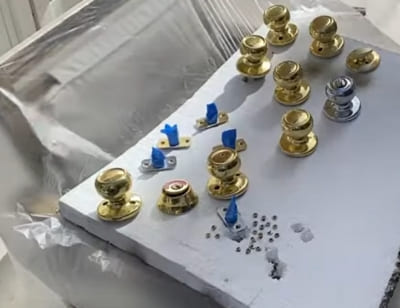
Painting over brass or metal can transform an object and give it a fresh new look. To start, make sure the surface is clean. I suggest you grab a rag and some soapy water to remove dirt or grime. If the metal is stubbornly dirty, you should choose glass cleaner with ammonia for a thorough cleanse.
Once clean, rinse the metal thoroughly and dry it completely. Now, I recommend finding a suitable spot outdoors on a clear day. Lay down some newspaper to protect the surrounding area.
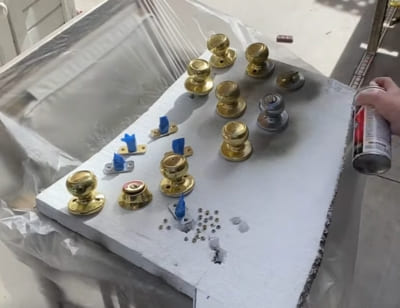
Next, it’s primer time. I tried using a self-etching primer or bonding primer (brass primer paint) which is really great for metal surfaces. Ensure the primer’s instructions explicitly mention its compatibility with metal or shiny surfaces to avoid any post-painting mishaps. Apply an even coat of primer, and if needed, I suggest adding a second layer for complete coverage.
Now comes the fun part – painting! Choose your preferred spray paint color and coat the primed metal object evenly. There’s no need for specialized spray paint; I did find that any type should work fine over the primer.
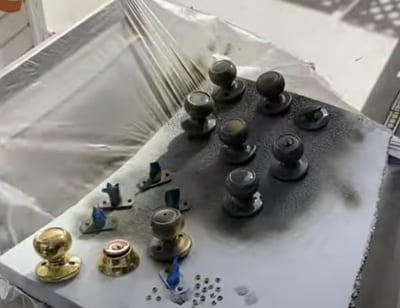
Once the paint has dried completely, it’s time to seal the deal. Apply a clear acrylic sealer over the painted surface to protect it from chipping and to give it a polished finish.
Conclusion:
Painting brass is a simple and effective way to update the look of your brass items or fixtures. Whether it’s a brass lamp, door handle, or decorative piece, painting it can give it a fresh new appearance. By following a few basic steps, you can transform your brass items into stylish decor pieces that match your taste and home decors.
FAQS
Can Brass Be Painted?
Yes, you can paint brass! First, clean the brass surface well. Then, apply a special primer made for metal. After that, you can use acrylic paint or any other spray paint. The primer helps the paint stick better for last a long time!
What Kind of Paint Will Stick to Brass?
Enamel paint or acrylic metal paint is indeed the best choice for painting brass, as it’s formulated to adhere well to metal surfaces like brass and provides a durable finish. You can also try using latex paint, oil-based or other types of paint that dry hard. I would suggest grabbing a bonding primer, which you can easily find at a local paint store or search online. These primers are specially made for brass creating a surface that your paint will adhere to beautifully.
Can you put varnish on brass?
Yes, you can use varnish on brass to protect it and keep it looking good. First, clean the brass well to get rid of any dirt or old varnish. Then, apply the varnish using a soft brush or cloth, following the instructions on the varnish can. Put on multiple thin coats, letting each one dry before adding another.
Can I paint lacquered brass?
Yes, you can paint over lacquered brass, but it’s essential to prepare the surface properly for the paint to adhere effectively. Begin by removing the old lacquer using a boiling water and baking soda solution or a varnish remover. Once the surface is clean and free of lacquer, apply a primer suitable for metal surfaces before painting with your chosen paint color. This ensures a smooth and durable finish on your brass-plated items, such as lighting fixtures, furniture, or doorknobs.

Rosalie Sanchez
DIY enthusiast with years of experience in home decor and home improvement. With a passion for educating consumers about DIY projects. Every time, I work with our painting professionals to provide you with the best painting product reviews and how-to advice. You can follow me on Facebook.


